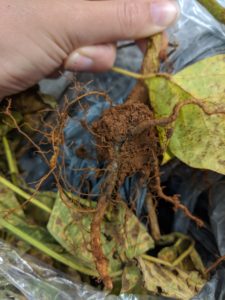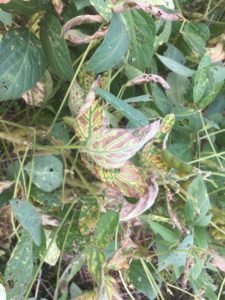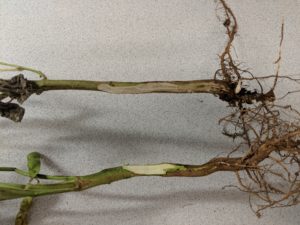Sudden Death Syndrome Observed in North Carolina Soybeans
go.ncsu.edu/readext?544410
en Español / em Português
El inglés es el idioma de control de esta página. En la medida en que haya algún conflicto entre la traducción al inglés y la traducción, el inglés prevalece.
Al hacer clic en el enlace de traducción se activa un servicio de traducción gratuito para convertir la página al español. Al igual que con cualquier traducción por Internet, la conversión no es sensible al contexto y puede que no traduzca el texto en su significado original. NC State Extension no garantiza la exactitud del texto traducido. Por favor, tenga en cuenta que algunas aplicaciones y/o servicios pueden no funcionar como se espera cuando se traducen.
Português
Inglês é o idioma de controle desta página. Na medida que haja algum conflito entre o texto original em Inglês e a tradução, o Inglês prevalece.
Ao clicar no link de tradução, um serviço gratuito de tradução será ativado para converter a página para o Português. Como em qualquer tradução pela internet, a conversão não é sensivel ao contexto e pode não ocorrer a tradução para o significado orginal. O serviço de Extensão da Carolina do Norte (NC State Extension) não garante a exatidão do texto traduzido. Por favor, observe que algumas funções ou serviços podem não funcionar como esperado após a tradução.
English
English is the controlling language of this page. To the extent there is any conflict between the English text and the translation, English controls.
Clicking on the translation link activates a free translation service to convert the page to Spanish. As with any Internet translation, the conversion is not context-sensitive and may not translate the text to its original meaning. NC State Extension does not guarantee the accuracy of the translated text. Please note that some applications and/or services may not function as expected when translated.
Collapse ▲Soybeans submitted through the Plant Disease and Insect Clinic have been confirmed to have the causal agent of Sudden Death Syndrome (SDS), Fusarium virguliforme (syn. Fusarium solani f. sp. glycines). This disease is not annually a problem in the region, but recent wet weather is likely influencing its presence.
Disease symptoms are most prevalent after flowering. Symptoms of SDS include interveinal chlorosis and necrosis, and, when stems are split, vascular tissue will appear tan to light brown. These symptoms are similar to those caused by Fusarium wilt, caused by Fusarium oxysporum, which is often seen in NC when plants are damaged or have root knot nematode infections. Unlike Fusarium wilt, SDS produces blue fungal mats that may be seen on the root tissues. SDS can also be easily confused with symptoms caused by stem canker or brown stem rot. Stem canker and brown stem rot will produce noticeable cankers on the outside of the stem tissue and produce significant discoloration of the vascular tissue.
Management options for SDS are limited. Foliar fungicide applications will have no impact on SDS suppression. Improving soil drainage where possible can reduce incidence. Soil compaction can also cause damage to soybean roots, which increases SDS incidence. There is an association with Soybean Cyst Nematode (SCN) and SDS. Managing nematode populations through good crop rotations can limit SDS damages; however, just a 2-year rotation may not be sufficient to reduce incidence from SDS. While there are no highly resistant cultivars available, cultivars with some degree of resistance to SDS should be used where possible.
Should you be concerned about SDS in your soybean fields and have further questions, contact your local Cooperative Extension Agent.





